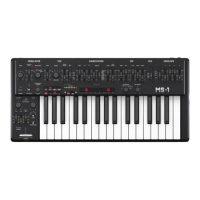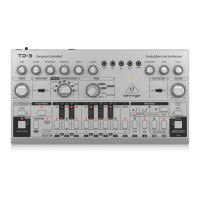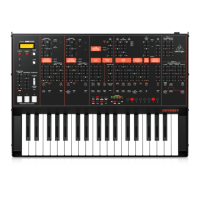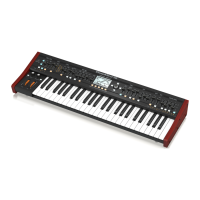this manual.
HARDWARE SETUP
Make all the connections in your system. Apply power to the MONOPOLY using the supplied power adapter only.
Ensure your sound system is turned down. Turn on the MONOPOLY power switch.
WARM UP TIME
We recommend leaving 15 minutes or more time for the MONOPOLY to warm up before recording or live
performance. (Longer if it has been brought in from the cold.) This will allow the precision analog circuits time to
reach their normal operating temperature and tuned performance.
FIRST SOUNDS
The following steps will help you start making sounds from your new synthesizer:
1. Turn up the VOLUME a small amount, and make sure the adjacent switch is set to High or Low (not Off).
2. Turn the VCF CUTOFF to maximum.
3. Turn the VCA EG SUSTAIN to 5 or more, and ATTACK to 0.
4. Turn the VCO1 LEVEL to maximum, and its WAVEFORM to triangular.
5. For the wheels to work, set their INTENSITY knobs to 5 or more. Initially, set the MG1 wheel to minimum.
6. Play the keyboard and adjust the volume to a safe and comfortable level.
7. Adjust the LEVEL and WAVEFORM of the other VCOs and experiment with the settings and tuning.
8. The NOISE LEVEL can also be adjusted to add white noise.
VCO SECTION
The MONOPOLY has four voltage controlled oscillators (VCO), and an internal Noise generator. Each of these, and
any combination, are used to generate sound. The VCO controls allows you to adjust the volume of each VCO,
select its waveform, its octave, and its tuning. The MASTER TUNE adjusts all VCOs at the same time. DETUNE will
slightly separate the tuning of each VCO to create a fatter sound similar to an ensemble. TRANSPOSE will move all
VCOs up or down an octave. If you select PWM and PW waveforms, then you can adjust the modulation of the
PWM, and the width of the PW.
VCF FILTER AND EG SECTION
The voltage controlled filter (VCF) is a low-pass filter, where audio frequencies above the cutoff frequency are
attenuated. Adjust the Cutoff Frequency, Resonance, and Intensity, and listen to their effects on the sound. In the
VCF EG envelope generator, adjust the Attack time, Decay time, Sustain level and Release time; they affect the
cutoff frequency with time, when a note is played. The VCF EG can also affect the modulation of the PWM waveform,
and the frequency modulation in the Effects section. The keyboard tracking knob affects how much the filter is
affected by the frequency of notes that are played.
VCA EG SECTION
Adjust the voltage controlled amplifier envelope generator controls: Attack time, Decay time, Sustain level, and
Release time. These affect the overall level with time, when a note is played.
MG1 and MG2
These are two separate modulation generators, and each can modulate different parameters for very interesting
effects.
MG1 has a frequency control, and the waveform can be selected from triangle, reverse-sawtooth, sawtooth, and
pulse. MG1 can be used to modulate the width of the PWM waveform, and the frequency modulation in the effects
section. The MG1 wheel adjusts the intensity, and it can modulate VCO1 (or slave VCO, if EFFECTS is on), the pitch,
or the VCF cutoff frequency.
MG2 has a frequency control, and a triangular waveform. The frequency control can be used to adjust the Arpeggio
tempo (make sure it is not on zero when using Arpeggio). MG2 can also modulate the width of the PWM waveform.
KEY ASSIGN MODE
These illuminated switches select how the keyboard is assigned to the synthesizer, with HOLD, 2 monophonic, and 2
Polyphonic modes.
HOLD – holds all notes played. (Select a KEY ASSIGN switch, before pressing HOLD.)
CHORD MEMORY – play and hold any desired chord in POLY or UNISON/SHARE mode, and then press CHORD
MEMORY. The chord will be memorized and can be played back with a single key press. Any note played will
represent the lowest note of the chord. Note: The memory is saved unless CHORD MEMORY is pressed when notes
are still being held, or if the synthesizer is turned off. HOLD can be used to help create the chord, and CHORD
MEMORY can also be used with the Arpeggiator.
UNISON – this monophonic mode plays all the VCOs when playing one key. Each VCO can be adjusted individually.
UNISON/SHARE – this polyphonic mode automatically shares the number of notes played, among the VCOs:
1 note: VCO1-4
